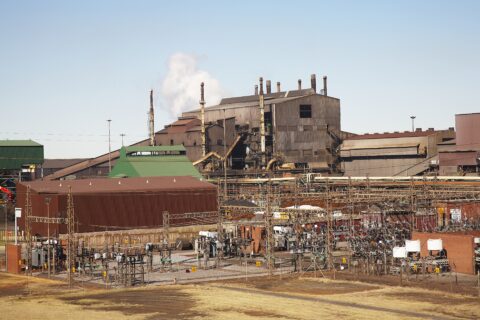SA Mining
Power To The People
By: Nelendhre Moodley
On the back of South Africa’s constrained power situation and rising tariffs, owing in part to the high cost of coal, coal miner Canyon Coal is prepared to supply coal at prices that will benefit the country, Menar chairman Mpumelelo Mkhabela tells SA Mining.
Canyon Coal, a subsidiary of mining investment company Menar, is focused on developing coal projects.
“Ensuring that we supply Eskom with good-quality coal at good prices will benefit business, communities and the country as a whole. Given that every ordinary South African has a stake in Eskom, it is our collective duty to ensure that it is a success, failing which we all suffer. As such, we have an obligation to assist Eskom and ensure that the power utility succeeds.”
Mkhabela echoed views expressed by Menar MD Vuslat Bayoglu who told a coal mining symposium in Middelburg that supplying coal to Eskom at exorbitant prices was self-defeating. “If you are selling coal to Eskom at a high price and you are proud of it, then there is something wrong with you,” Bayoglu said.
So dire is the situation that the South African government recently implored all coal producers who supply to Eskom to cut prices, to ease the utility’s debt burden and improve reliability of energy supply to industry and households.
Canyon Coal currently produces 5mtpa, while Menar as a group produces 7.5mtpa of coal for mostly the export market, with plans in place to bump up production to 20mtpa of coal in the next year.
Part of the new production has been earmarked for possible supply to Eskom – with the miner having identified its Palmietkuilen coal project in Springs, 50km east of Johannesburg, as ideal for Eskom.
“The Palmietkuilen coal project easily ticks all the boxes for Eskom requirements. The project is going through the latest round of regulatory approvals. It is more than three times the size of our Khanye Colliery in Bronkhorstspruit which we invested R600-million,” Mkhabela said.
Canyon plans to invest as much as R1.5-billion to develop Palmietkuilen.
“There are huge expectations in the host community for jobs, procurement opportunities for local business people and economic development initiatives,” Mkhabela said.
“We need to work together with the government to create a conducive environment for this investment to succeed. We cannot fail the community and our country,” he said.
Production from the Palmietkuilen project, estimated to deliver 600 000tpm run-of-mine coal for the next 27 years, is scheduled to start in 2020 when it is expected the project would have gone through all the regulatory processes.
Once operational, the Palmietkuilen mega mine will employ about 800 people.
Given South Africa’s high unemployment rate, which stands at a staggering 29%, Canyon Coal is looking to absorb a portion of the unemployed through the progression of its growth strategy.
“Our plan to produce 20mtpa of coal will significantly increase our current employment rate of 3 800 people,” said Mkhabela. “Unlike big mining companies, we still have an appetite to invest and grow.”
The coal miner has also identified its Springfield coal project located in Vereeniging in Gauteng and De Wittekrans, a greenfields project located south of Hendrina, in Mpumalanga, as suitable for the supply of coal to Eskom, depending on the power utility’s needs. De Wittekrans is expected to come on-stream in 2020, followed by Springfield the following year.
The Springfield project has an estimated life of mine of around 40 years based on an ROM production of around 600 000t/m, while De Wittekrans has an estimated life of mine of some 24 years based on an ROM production of around 300 000t/m.
Apart from these projects, Canyon Coal operates the Hakhano Colliery, an opencast coal mine located near Middelburg, Mpumalanga, which it has been mining since December 2009, the Ukufisa Colliery in Springs (where phase 1 of the project is under development), Phalanndwa Colliery located close to Delmas, Mpumalanga, and Khanye Colliery, its flagship opencast mine in Bronkhorstspruit, Gauteng. The Khanye Colliery, a 2.4mtpm operation, consists of three pits, a processing plant and rail siding. The operation currently employs 405 people including contractors.
A case for coal
With coal majors South32 and Anglo Coal signalling their intention to exit the commodity, junior and mid-tier companies are preparing to take up the gauntlet to progress the development of coal projects. Mkhabela says it’s important that major mining companies who seek to divest from coal do so responsibly by giving the assets to companies who are willing to invest and develop assets and create jobs.
“At Menar we believe that coal has an important role to play in promoting radical industrialisation and economic development. In fact, countries such as India and Vietnam are looking for cheap and reliable power to drive their radical industrialisation programme. Globally there are 1 600 coal-fired power stations being built. South Africa should also look at unlocking further opportunities offered by this natural endowment,” says Mkhabela.
Aside from job creation and foreign exchange, coal is vital for growing the South African economy, he adds.
Speaking of the recently promulgated integrated energy plan, Mkhabela said it was a good plan. “The integrated energy plan acknowledges that coal will continue to play a key role in South Africa’s economic development, especially given that the country relies on 16 coal-fired power stations,” he said.
Community development
Canyon Coal is looking to create as many jobs as possible and providing its employees and the communities surrounding its operation with a stake in its coal operations.
“Communities are aware of their rights and as a company we are keen to have community participation. At our Kangra mine in Piet Retief we offered employees and the communities 5% ownership in the mine. At Zululand Anthracite workers own 13% of the mine, while the community also has a 13% shareholding. Our approach to empowerment also targets local communities who are allocated procurement opportunities.”
Progressing a diversification strategy
A key component of Canyon Coal’s growth strategy is to diversify its portfolio, which currently consists of metallurgical and thermal coal as well as anthracite, to include manganese.
The manganese asset, located in Hotazel in the Northern Cape, had cleared all regulatory licences, aside from the water-use licence, the company said.
“Once we are in possession of the water-use licence, we will start mining,” said Mkhabela. Manganese production is anticipated by the first quarter of 2020.






 Sign-up and receive the Business Media MAGS newsletter OR SA Mining newsletter straight to your inbox.
Sign-up and receive the Business Media MAGS newsletter OR SA Mining newsletter straight to your inbox.